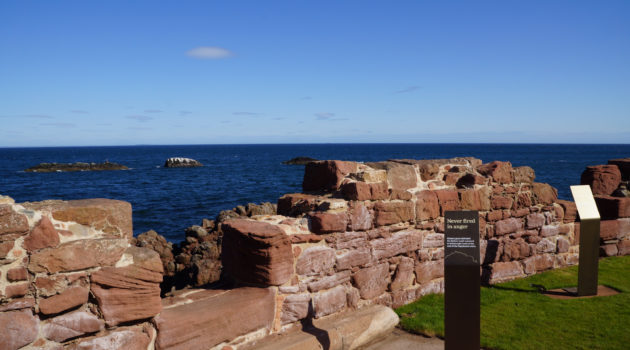An early visitor asked where St Bey’s church used to stand.
Roy Pugh, one of Dunbar’s pre-eminent historians, explains:
Bey originated in County Down, Ireland. She came to Britain in the 7th century and reputedly first began her ministry in St Bees (a corruption of her name) in Cumbria. She came to Scotland in the 7th century, befriending Ebba of Coldingham Priory and Helen of Aldcambus (near Cockburnspath). She challenged these two to a contest as to which could build a church closest to the sea which gave rise to the old Northumbrian poem which appears at the Battery. St Bey won; her church of St Anne’s (Anne was the mother of the Virgin Mary) was built closest to the sea, but where?
There is an unsubstantiated tradition that it was on the sands on the site of the former open air swimming pool, as the cave on the cliff is known as St Bey’s Cave, the shoreline is St Bey’s Shore and there was a well called after her – hence Bayswell Road. However, another tradition has it that her church was built at the East or Coastguard Beach, near Lamer Street. This may not be without foundation as in 1951, an early Christian cemetery was discovered at Kirkhill Braes, Roxburghe Terrace. (Some of the skeletons were inspected before they were removed; these were subsequently confirmed as 6th to 10th century burials.)
However, after she built her church, Bey moved away to Little Cumbrae on the west coast, living on the island as a hermit amongst her beloved animals and birds until her death. As she preferred the life of a hermit, this might explain why she lived in her cave at Dunbar which at that time was a small settlement occupying what is now the site of the indoor swimming pool. As to the reference to the parish church, we know there was a church there in the 12th century as it is mentioned in the 1170 taxation; it was dedicated to Bey, she being recognised as Dunbar’s patron saint. It is unlikely that church was St Bey’s as her church was built before AD683, the year that St Ebba died.
Further information can be found on pages 136 and 171 of Roy Pugh’s History of Dunbar, 2015.

